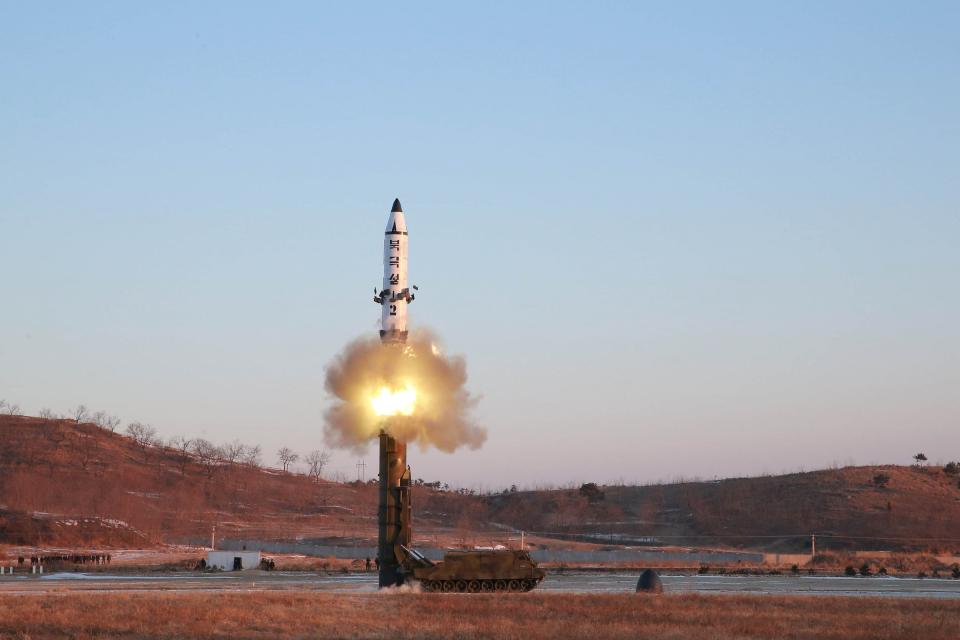Here's why the US would have to be insane to attack North Korea

KCNA via Agence France-Presse
Despite reports of US and Chinese military buildups, North Korea's increased pace of provocations, and the Trump administration's claims that "all options are on the table," the US would have to be insane to attack North Korea.
To the untrained eye, the preparations for war are all there. The US has deployed the world's most advanced missile-defense system to South Korea, to protect against ballistic missiles. The world's most advanced jet, the F-35, has been sent to Japan.
The US has a carrier strike group, the most powerful unit of naval power in existence, near North Korea's shores. And the US has permanently stationed 25,000 members of the world's best-organized fighting force near the North's borders — and they just finished a massive military exercise.
But even the best systems can't stop a determined foe with a handful of nukes.
Adm. Dennis Blair, who was the director of national intelligence under President Barack Obama, recently told a crowd at the Harvard Club that there was just no way to safely knock out all of North Korea's nuclear capabilities in one go.
"If I were to run the national intelligence again and the president comes to me and says, 'Here is General Mattis' strike plan, and can you ensure me that this will take out of all the North Korea nuclear capabilities?' it won't be easy to say yes," Blair said, according to The South China Morning Post.
Blair said that before he'd advocate an attack on North Korea, he'd accept it as a nuclear-armed state.
Blair's statement echoes Secretary of Defense Jim Mattis' recent admission that a fight with the North would be "tragic on an unbelievable scale."

Lee Jin-man/AP
The US has 2,300 nuclear weapons, any one of which could hit North Korea at a moment's notice. North Korea may have about a dozen nuclear weapons and the ability to hit a few close targets within an hour or so of planning.
But it takes only a single nuclear detonation to make conflict inevitable. Unlike the US's surgical and virtually unpunished April 7 strike on a Syrian airfield, North Korean missiles would likely return fire thick and fast.
Experts say North Korea probably would respond with artillery fire that would light up Seoul and its 10 million residents, decoy missiles would streak across the sky to overwhelm missile defenses, and ground forces would pour in through hidden tunnels.
The US and South Korea undoubtedly would smash North Korean forces in time, but not before a missile touched down or another catastrophic act of war befell thousands, if not hundreds of thousands, of innocent South Koreans.
According to Bonnie Glaser, director of the China Power Project at the Center for Strategic and International Studies, only one military option even begins to make sense for North Korea.
"If North Korea has a ballistic missile on a launchpad that we think is armed with a nuclear warhead," then the US would seek to eliminate that one single missile, Glaser said. "But even a strike on a missile on a launchpad could result in retaliation."

KCNA/Handout via Reuters
After all, how should the North Koreans know that incoming missiles from the US had a limited objective? The risk remains that they'd misinterpret a limited strike as a full-on attack.
And the idea of eliminating a single, consolidated threat from North Korea simply is a dream. North Korea may very well be beyond using launchpads, as its recent missile tests have taken off from mobile launchers, many of which have tank-like treads to allow it to fire from hidden locations in the wilderness.
All three options for dealing with North Korea — ineffective sanctions, conceding to nuclear blackmail, and military action — are terrible. But the most terrible and unlikely is direct military action.
NOW WATCH: South Korea requires all males to serve in the military — here's what it's like
See Also:

 Yahoo News
Yahoo News 

